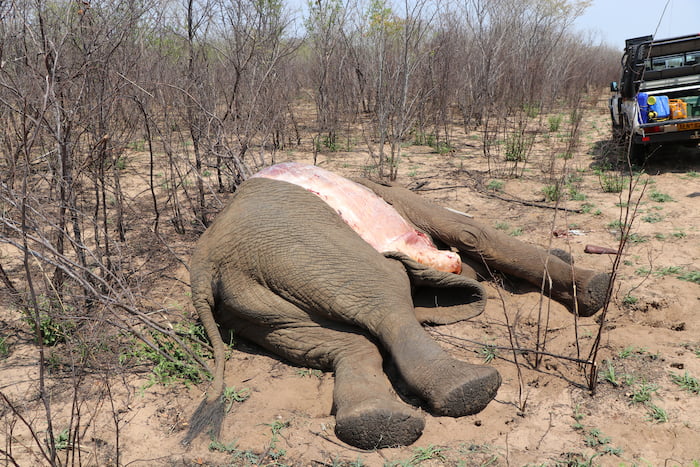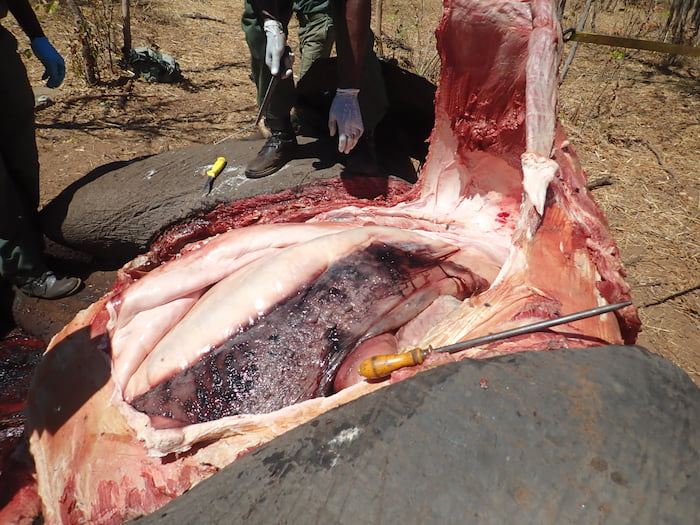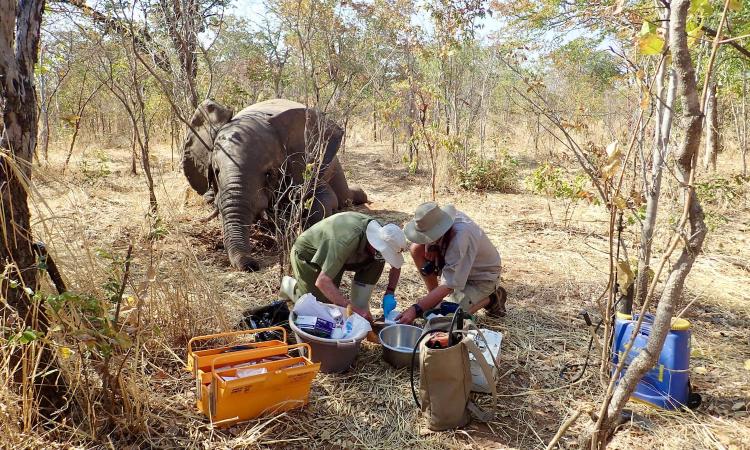A research project led by Victoria Falls Wildlife Trust’s veterinarian, Dr Chris Foggin and a team of international scientists were pleased to announce the scientific publication of their results and confirm that they found why African elephants in Zimbabwe suddenly dropped dead in 2020. Their research suggests that a little-studied bacterium closely associated with deadly septicaemia, Pasteurella Bisgaard taxon 45, was responsible for some of the deaths.
Warning: Some images in this article contain graphic content related to wildlife fatalities, which may be distressing to sensitive viewers.
Core Lessons
- Rare Bacterium Identified: Pasteurella Bisgaard taxon 45 caused fatal septicaemia in Zimbabwe’s elephants.
- Investigation Challenges: Deteriorating samples and COVID-19 delays complicated the study.
- New Conservation Threat: Infectious diseases now add to poaching and habitat loss as dangers to African elephants.
- No Further Recurrence: No further cases have been reported since 2020, but ongoing research is vital.
Endangered African Elephants: Species Under Threat in Zimbabwe
According to the International Union for Conservation of Nature, the African savanna elephant is already an endangered species. An estimated 350,000 remain in the wild, and the population decline is eight percent annually, mostly due to poaching and habitat loss.

Zimbabwe has about one-quarter of the elephants in Africa, and more than half roam freely within and outside the sprawling, unfenced Hwange National Park. With about 100,000 elephants, Zimbabwe has the world’s second-largest population after the 130,000 in Botswana.
The recently released findings from a unique collaboration of scientists suggest that infectious diseases should be added to the list of pressures they are facing. The investigation has uncovered the potential cause of the mysterious deaths and highlights the importance of continued research for the future of African elephants.
2020 Elephant Deaths in Zimbabwe: Understanding the Mortality Events
In 2020, 350 elephants died in Botswana during May and June. Then, between late August and November, in similar circumstances, 35 elephants suddenly dropped dead in Zimbabwe.
“They died over a very narrow window. That’s one of the enigmatic parts of the whole puzzle. That many animals dying quite close together but not right next to each other over such a narrow space in time. It’s really to my mind, rather unique, certainly in this part of the world.” said Dr Chris Foggin, wildlife veterinarian at the Victoria Wildlife Trust.
In 2020, the Zimbabwe Parks and Wildlife Management Authority and the Victoria Falls Wildlife Trust investigated the series of deaths in northwestern Zimbabwe. Elephants of all ages and both sexes were affected, with many walking in circles before dying suddenly, collapsing on their faces. At first, anthrax was suspected as it is known to occur in the area. The scientists also tested for cyanide, which is sometimes used to poison elephants, but there were no traces of any poisons in the carcasses or near the waterholes. Other theories included the ingestion of algal blooms. Poaching was immediately ruled out because the carcasses all still had their tusks attached.
“Veterinarians don’t open the carcass when anthrax is suspected to avoid contaminating the environment with anthrax spores. Instead, we take samples such as blood smears and then burn the carcasses, if possible. When the first elephant died, it looked like anthrax. Minimal samples were taken, and the carcass was burned.” said Laura Rosen, an epidemiologist at the Kavango-Zambezi Transfrontier Conservation Area’s Animal Health sub-working group.

Challenges in Investigating Mysterious Elephant Deaths in Zimbabwe
An international team of scientists from the University of Surrey, the UK government’s Animal and Plant Health Agency, the Victoria Falls Wildlife Trust and South African laboratories partnered in the investigation.
The team led by Dr Chris Foggin said that investigating the mass deaths had been challenging. “Identifying and then reaching the carcass in time to obtain useful samples is often one problem we face. However, we also didn’t know what disease we may be dealing with.”
The scientists were unable to visit the site in Botswana, and most samples in Zimbabwe were collected from animals that had already started rotting. The findings of blood poisoning “may represent an ongoing phenomenon in this region,” with previous cases missed due to a lack of testing.
The initial findings in the elephants’ postmortems and laboratory results found that they suffered inflammatory bleeding of the internal organs, enlarged spleens and livers, as well as tissue death.
The researchers said they failed to detect the bacteria in some of the samples, but this could be because “Most carcasses were degraded at the time of sampling, making the sample quality poor. Additionally, exporting wildlife samples for analysis involves obtaining multiple permits from different entities – a process which can take months.” The strain placed on testing centres across the world by Covid-19 affected the international shipment of samples from the elephants, which also slowed the process.

Scientific Findings: Rare Bacterium Linked to Elephant Deaths in Zimbabwe
An analysis published on 25 October 2023 in the journal Nature Communications has found that a rare bacterium caused organ inflammation, and they died from that lethal infection.
The study showed evidence that the infection by the little-known bacterium Bisgaard taxon 45 had caused septicaemia or blood poisoning. The deaths took place during a period when food and water resources dwindled, forcing the elephants to travel increasing distances to look for water and forage.
According to the paper, Bisgaard taxon 45 has previously been found in tigers and lions, chipmunks, and parrots. It is still unclear how the elephants became infected, whether the bacterium is part of their normal flora, and whether heat, stress, or other factors caused it to multiply and become deadly.
Dr Foggin said there was no proven connection between the Zimbabwe and Botswana elephant deaths. In addition, researchers have been monitoring wildlife in the area, but no further deaths from Bisgaard taxon 45 have been confirmed since 2020.
The Victoria Falls Wildlife Trust began in 2008 and is based in Zimbabwe, in the Victoria Falls National Park. They are a crucial conservation team in the centre of the Kavango-Zambezi Transfrontier Conservation Area (KAZA TFCA), the world’s largest transfrontier conservation area comprising five countries and 520,000 km2 of protected parks and forests, game and wildlife management areas, and communities.
Wildlife populations are under threat, and with little chance of that changing, the Victoria Falls Wildlife Trust works tirelessly to protect Zimbabwe’s wildlife and operates as a “boots on the ground “organisation. Under the banner of Conserve, Research and Commitment, the following cross-border conservation work and human-wildlife conflict projects are managed through mutually beneficial partnerships.
• Rescue and rehabilitation program
• Wildlife research
• Veterinary laboratory
• Community Outreach
• Countering wildlife crime.
They have the support of NGOs, the private sector, and key stakeholders, including governmental wildlife agencies, tribal leaders and rural communities.
More information on the Victoria Falls Wildlife Trust can be found at vicfallswildlifetrust.org
Reference and resource: Foggin, C.M et al. (2023)” Pasteurella sp. associated with fatal septicaemia in six African elephants” Nature Communications. Published online October 25, 2023. s41467-023-41987-z. “


